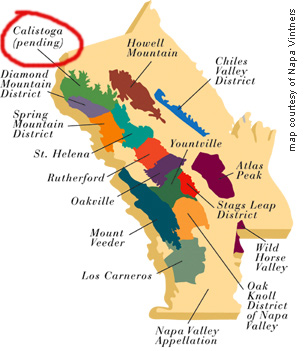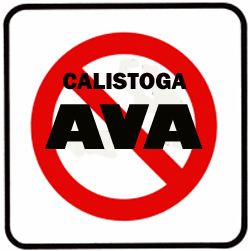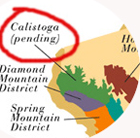

The part that's missing: the proposed Calistoga AVA is the long missing piece in the Napa Valley AVA map.
The Struggles Of Government Sanctioned Wine Regions
The proposed Calistoga AVA has challenged everybody concerned with it: the affected wineries, the Napa Valley Vintners, the Federal government, California, and indirectly every other American AVA.
by
Alan Goldfarb
April 14, 2009
 espite a new administration in Washington whose chief of staff is a signatory to a letter supporting the proposed Calistoga appellation, there has been no hint of a resolution to the donnybrook that’s been ongoing for more than five years. Thus, there still is no Calistoga American Viticultural Area (AVA), despite the fact that Bo Barrett of Chateau Montelena– who fosters the 15th sub-appellation to Napa Valley – told this writer at the end of September of 2003 (the year of application) that “I can’t imagine anyone contesting it. It’ll probably be the least controversial (AVA) they’ve (the Tax and Trade Bureau) ever did (sic).”
espite a new administration in Washington whose chief of staff is a signatory to a letter supporting the proposed Calistoga appellation, there has been no hint of a resolution to the donnybrook that’s been ongoing for more than five years. Thus, there still is no Calistoga American Viticultural Area (AVA), despite the fact that Bo Barrett of Chateau Montelena– who fosters the 15th sub-appellation to Napa Valley – told this writer at the end of September of 2003 (the year of application) that “I can’t imagine anyone contesting it. It’ll probably be the least controversial (AVA) they’ve (the Tax and Trade Bureau) ever did (sic).”
Of course, TTB still hasn’t ruled on the AVA because of two brands – Calistoga Cellars and Calistoga Estate– which allegedly do not use any grapes from Calistoga. But the owners of those labels have been steadfast in keeping their intellectual property intact, which has led to the imbroglio.
Marvin Stirman, who heads up a group that owns Calistoga Estates, when reached on his cell phone recently, told APPELLATION AMERICA, “I still think it’s unfair. I did everything I was supposed to do … and they (TTB) are going to make a decision regardless what I do. I just sit around waiting. There’s nothing I can do.”
On the other side, a spokesperson for the Napa Valley Vintners, a lobbying group representing the interests of the country’s most important wine region, is equally resolute in continuing the struggle. The group went to Washington in February to beseech officials there to put an end to the battle, and Rex Stults, the NVV’s industry relations director, came away discouraged.
“To be realistic where this rates in terms of national priorities … (But) we’re not giving up and we’re trying to keep it on the radar screen. Yes, it is (discouraging). The entire thing is ludicrous. Of all the projects I’ve worked on, it takes up the most time. We’re spending a lot of resources and staff time (on a proposal) that should have fallen into place very easily. It’s illogical to everybody who reads and understands it.”
Is there any positive feeling at the NVV that the Obama administration might resolve this matter? “Yes, there is. We’re hoping they’ll have a better outlook on
 consumer protection, which is what this is all about,” Stults said, referring to the hard-fought case the NVV won against the Bronco Wine Co. in the Supreme Court several years ago. Bronco, it was determined, could not use any geographical brand names if 85 percent of the grapes in the bottle did not come from that area.
consumer protection, which is what this is all about,” Stults said, referring to the hard-fought case the NVV won against the Bronco Wine Co. in the Supreme Court several years ago. Bronco, it was determined, could not use any geographical brand names if 85 percent of the grapes in the bottle did not come from that area.
Stults is also bolstered by the fact that President Obama’s chief of staff Rahm Emanuel is one of the people who signed a letter put forth last February by the Congressional Wine Caucus in support of the Calistoga AVA.
Stults is perplexed that Roger Louer, one of the owners of Calistoga Cellars, is still in the fight considering all the time and money he must have spent trying to preserve his label. Time and money that would have been saved if he had just changed his brand’s name two years ago when it was presented to him by the NVV. “I wonder what he would say now after all this time? But we don’t want Calistoga Cellars to go out of business,” Stults said.
Meanwhile, other AVA’s have been approved by TTB despite the fact that that bureaucratic organization insisted on freezing the naming of others in light of the Calistoga controversy. But once an appellation is approved, even then, those within a newly named region often have to struggle to get purchase from the concept.
For instance, a post graduate student, involved in promoting a wine region in Canada (which is not under the jurisdiction of the TTB), wonders about the efficacy of an appellation designation. In an e-mail, he asks: “I am looking to unlock secrets on how Napa has had success with this.”
He inquires further with a bevy of questions, “Is the sub-appellation system accepted by the industry? Who benefits the most? The least? Do you think it is properly promoted? Who promotes it the best? Does it add value? Do you think it’s important that wine consumers are aware of the different sub-appellations? How does the information get from wine influencers to the wine consumers?”
And, “What are the major factors that made and continue to make the system successful and how do you see it evolving in the future?”
How The French Do It
Even in France, where the appellation system has officially been in place since 1935, there are questions and difficulties in gaining capital, especially for newly named regions. France’s newest appellation, Les Côtes de Bordeaux, which came into effect with the 2008 vintage, is having its share of trials and tribulations.Consisting of four sub-appellations, Les Côtes, which comprises little-known sub-regions even inside of France – Premières Côtes de Blaye, Premières Côtes de Bordeaux, Côtes de Castillon, and the Côtes de Francs. The appellation’s director, Christophe Chateau, has his hands full trying to promote them.
When I met him in the city of Bordeaux last September, shortly after Les Côtes was sanctioned, Chateau told me: “We are good in France but bad for export (only 13 percent of Les Côtes’ wines are shipped out of the country) because we are not known and not in relation with the name ‘Bordeaux’. We had to change our name to make it easier to understand for consumers, especially overseas.”
Then there are the always unnerving reactions internally – from some producers within an appellation. “Some producers were saying that our appellations ‘are
 very famous all over the world, ‘so we don’t need to do anything’ (to secure an official appellation),” Chateau said.
very famous all over the world, ‘so we don’t need to do anything’ (to secure an official appellation),” Chateau said.
Additionally, and most glaringly, and perhaps familiar, there was vocal resistance within France that opposed the name Les Côtes de Bordeaux. Chateau told me that in particular, the folks from the Côtes du Rhône “were not happy with it”.
After 22 years(!), Les Côtes de Bordeaux was born. As for Calistoga, does that mean there might be 16 more years to go?










 READER FEEDBACK: To post your comments on this story,
READER FEEDBACK: To post your comments on this story,



